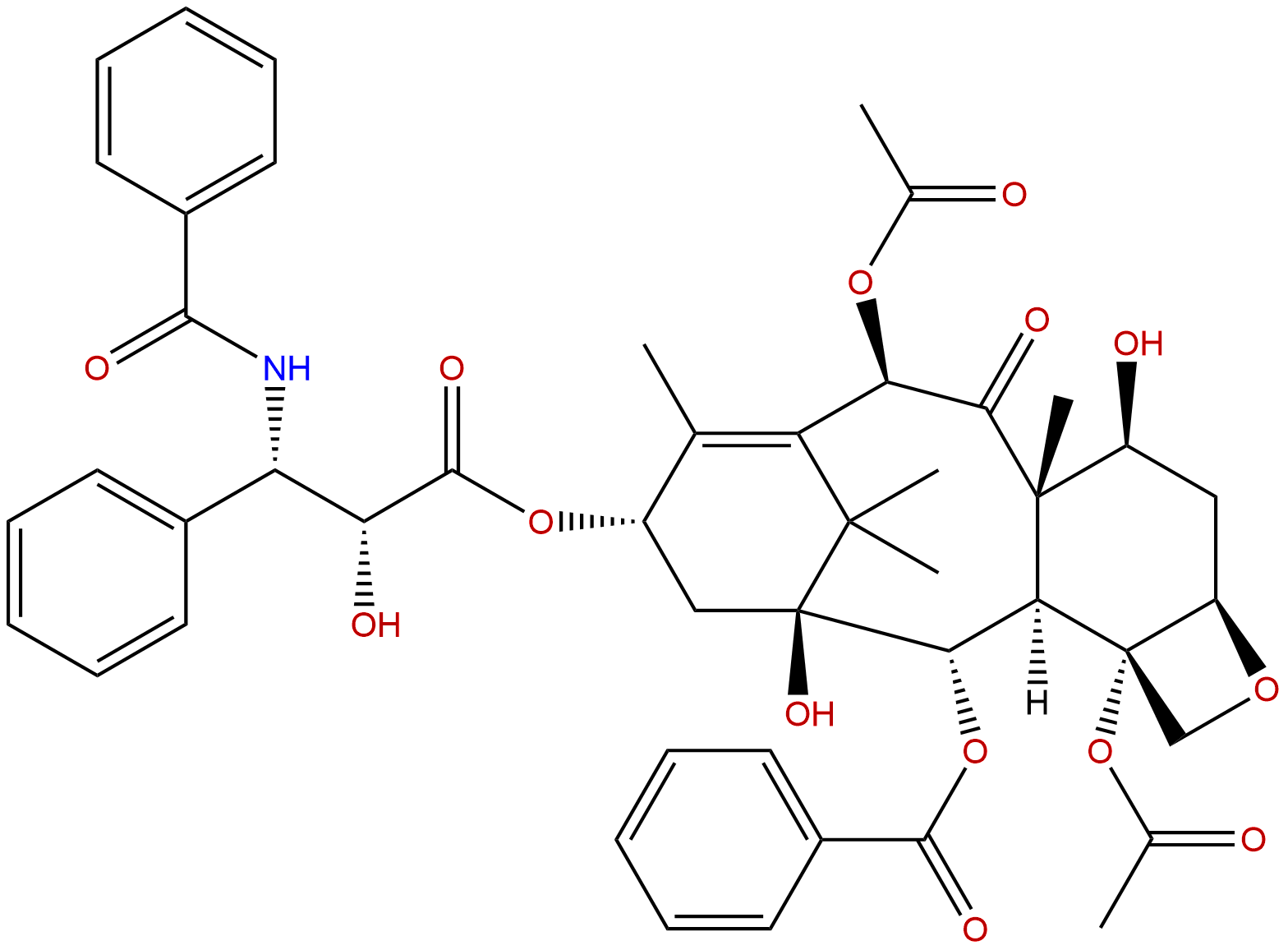
PaclitaxelCAS No.:33069-62-4
|
||||||||||
 |
|
|
||||||||

| Catalogue No.: | BP1055 |
| Formula: | C47H51NO14 |
| Mol Weight: | 853.918 |
Product name: Paclitaxel
Synonym name: Abraxane; Genaxol; Genetaxyl; OncoGel; Onxal; Pacliex; Taxol; Yewtaxan
Catalogue No.: BP1055
Cas No.: 33069-62-4
Formula: C47H51NO14
Mol Weight: 853.918
Botanical Source: Taxus chinensis
Physical Description:
Type of Compound: Diterpenoids
Purity: 95%~99%
Analysis Method: HPLC-DAD or/and HPLC-ELSD
Identification Method: Mass, NMR
Packing: Brown vial or HDPE plastic bottle
Storage: Store in a well closed container, protected from air and light. Put into refrigerate or freeze for long term storage.
Whenever possible, you should prepare and use solutions on the same day. However, if you need to make up stock solutions in advance, we recommend that you store the solution as aliquots in tightly sealed vials at -20℃. Generally, these will be useable for up to two weeks.
The product could be supplied from milligrams to grams
Inquire for bulk scale.
Description:
Paclitaxel is a potent anticancer medication which can promote microtubule (MT) assembly, inhibits MT depolymerization, and changes MT dynamics required for mitosis and cell proliferation. Paclitaxel can induce ototoxicity in rats.
References:
J Surg Res. 2015 Apr;194(2):622-30.
Antitumor activity of paclitaxel is significantly enhanced by a novel proapoptotic agent in non-small cell lung cancer.
Newer targeted agents are increasingly used in combination chemotherapy regimens with enhanced survival and improved toxicity profile. Taxols, such as Paclitaxel, independently potentiate tumor destruction via apoptosis and are used as first line therapy in patients with advanced non-small cell lung cancer (NSCLC). Procaspase-3-activating compound-1 (PAC-1) is a novel proapoptotic agent that directly activates procaspase-3 (PC-3) to caspase-3, leading to apoptosis in human lung adenocarcinoma cells. Hence, we sought to evaluate the antitumor effects of Paclitaxel in combination with PAC-1.
METHODS AND RESULTS:
Human NSCLC cell lines (A-549 and H-322m) were incubated in the presence of PAC-1 and Paclitaxel. Tumor cell viability was determined by a tetrazolium-based colorimetric assay (MTT assay). Western blot and flow cytometric analysis were performed to evaluate expression of PC-3 and the proportion of apoptotic cells, respectively. A xenograft murine model of NSCLC was used to study the in vivo antitumor effects of PAC-1. PAC-1 significantly reduced the inhibitory concentration 50% of Paclitaxel from 35.3 to 0.33 nM in A-549 and 8.2 to 1.16 nM in H-322m cell lines. Similarly, the apoptotic activity significantly increased to 85.38% and 70.36% in A-549 and H322m, respectively. Significantly enhanced conversion of PC-3 to caspase-3 was observed with PAC-1 Paclitaxelcombination (P < 0.05). Mice treated with a drug combination demonstrated 60% reduced tumor growth rate compared with those of controls (P < 0.05).
CONCLUSIONS:
PAC-1 significantly enhances the antitumor activity of Paclitaxel against NSCLC. The activation of PC-3 and thus the apoptotic pathway is a potential strategy in the treatment of human lung cancer.
Laryngoscope. 2015 May;125(5):1175-82.
Investigation of protective role of curcumin against paclitaxel-induced inner ear damage in rats.
The aim of this study was to investigate the potential protective effect of curcumin on Paclitaxel-induced ototoxicity in rats by means of immunohistochemical and histopathological analysis and distortion product otoacoustic emissions (DPOAEs).
METHODS AND RESULTS:
Forty Sprague-Dawley rats were randomized into five groups. Group 1 was administered no Paclitaxel and curcumin during the study. Groups 2, 3, 4 and 5 were administered 5 mg/kg Paclitaxel; 200 mg/kg curcumin; 5 mg/kg Paclitaxel, followed by 200 mg/kg curcumin; 200 mg/kg curcumin and a day later 5 mg/kg Paclitaxel followed intraperitoneally by 200 mg/kg curcumin once a week for 4 consecutive weeks, respectively. After the final DPOAEs test, the animals were sacrificed and their cochlea were prepared for hematoxylin and eosin and caspase-3 staining. The DPOAEs thresholds and histopathological and immunohistochemical findings were substantially correlated in all groups. The histopathologic findings in the cochlea of the Paclitaxel-treated animals showed not only changes in the organ of Corti, but also damage to the stria vascularis and spiral limbus, including nuclear degeneration, cytoplasmic vacuolization, and atrophy of intermediate cells. Additionally, cochlear changes in group 2, such as intense apoptosis, were confirmed by caspase-3 immunohistochemical staining. In group 4, coreceiving curcumin could not sufficiently prevent Paclitaxel-induced ototoxicity, and the results in group 5 were similar to the control group.
CONCLUSIONS:
In our study, we have concluded that pre- and coreceiving curcumin can significantly protect the cochlear morphology and functions on Paclitaxel-induced ototoxicity in rats. Curcumin might be considered as a potential natural product that, used as a dietary supplement, could be easily given to patients undergoing Paclitaxel chemotherapy.